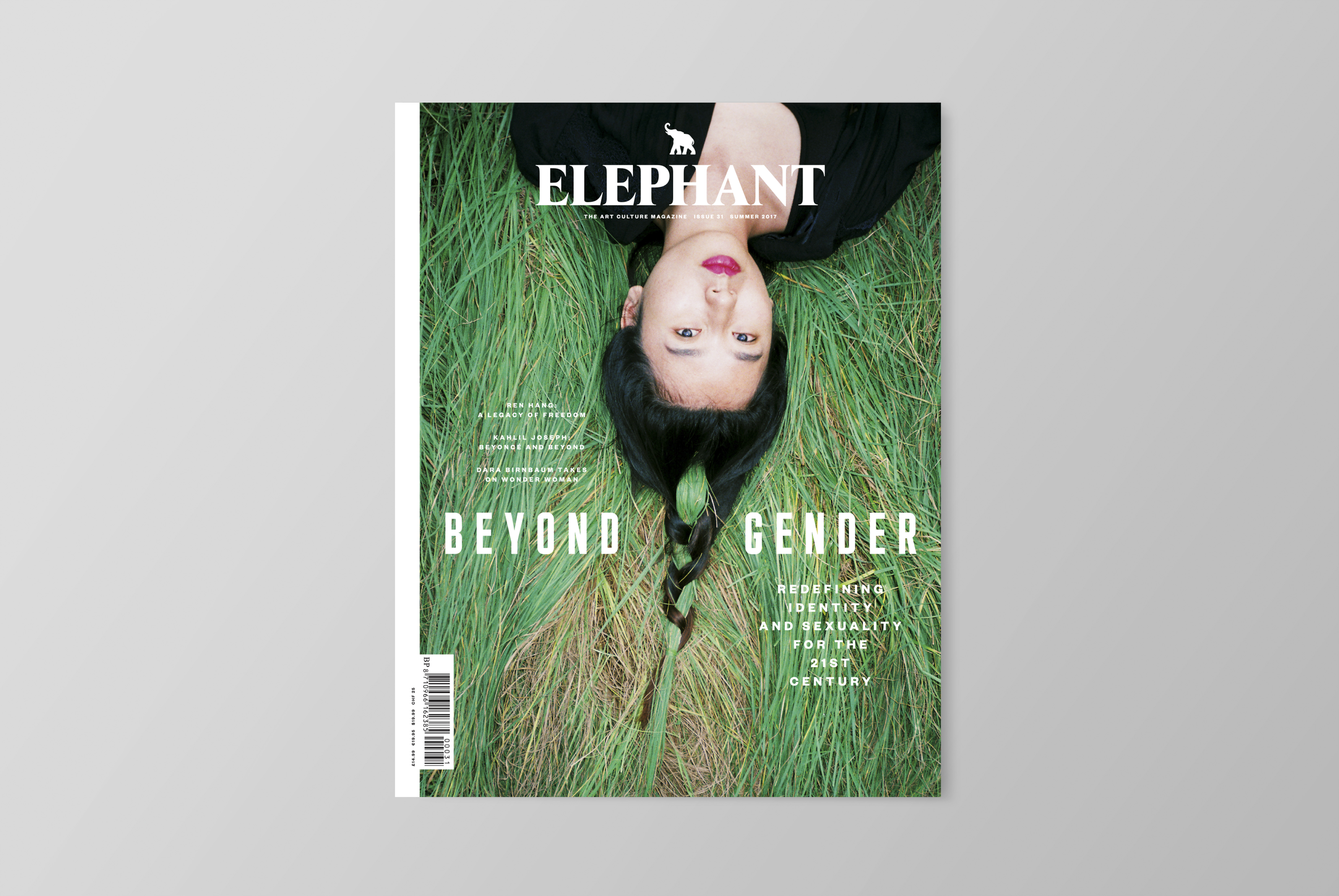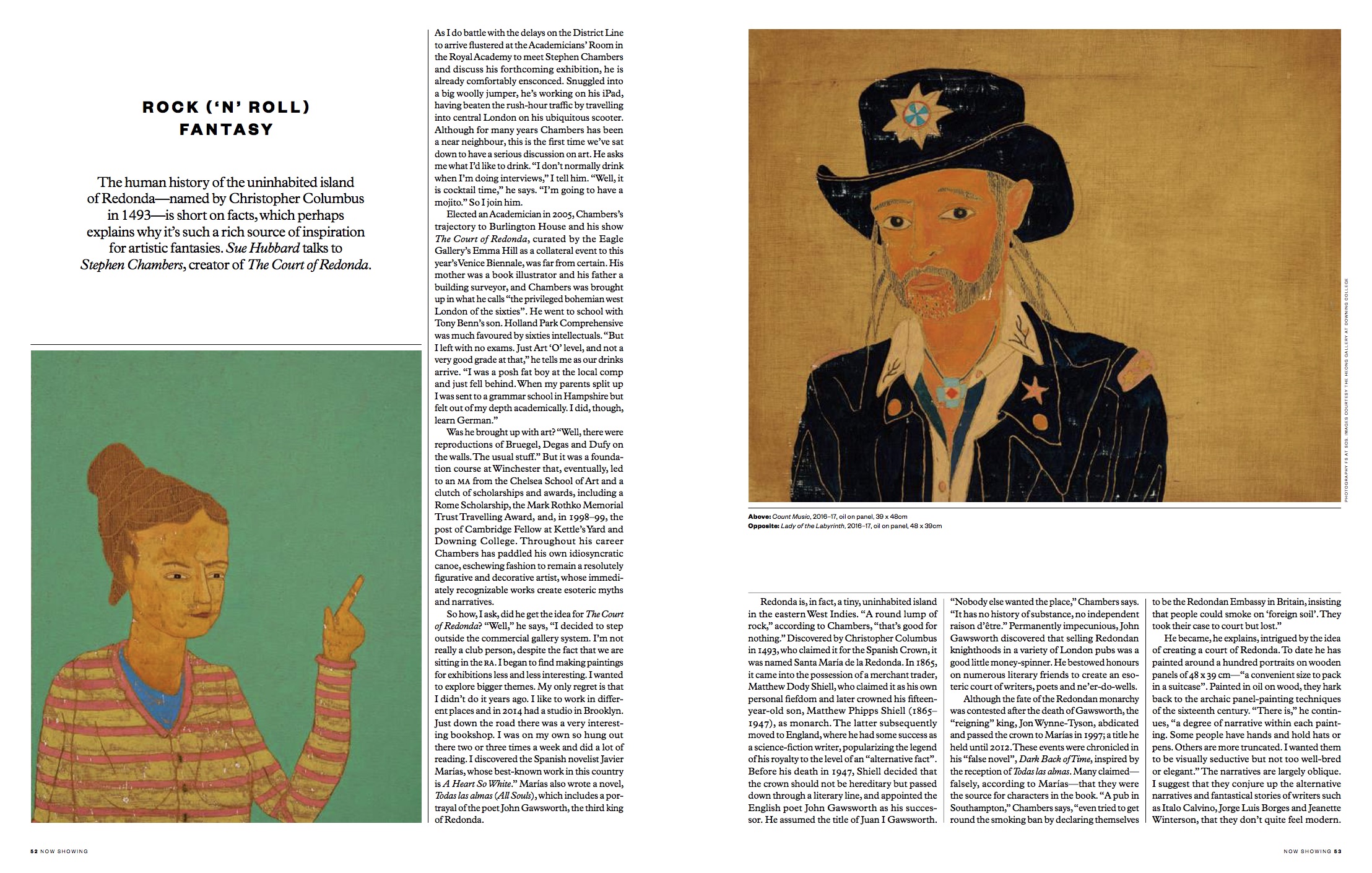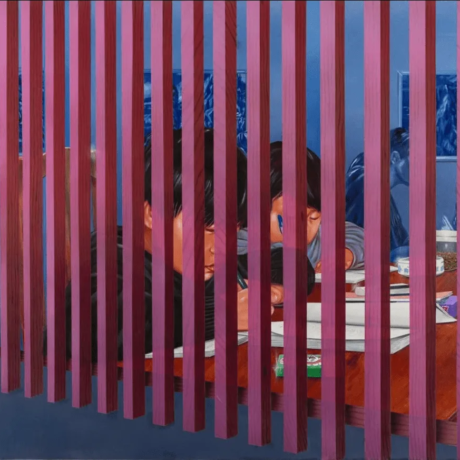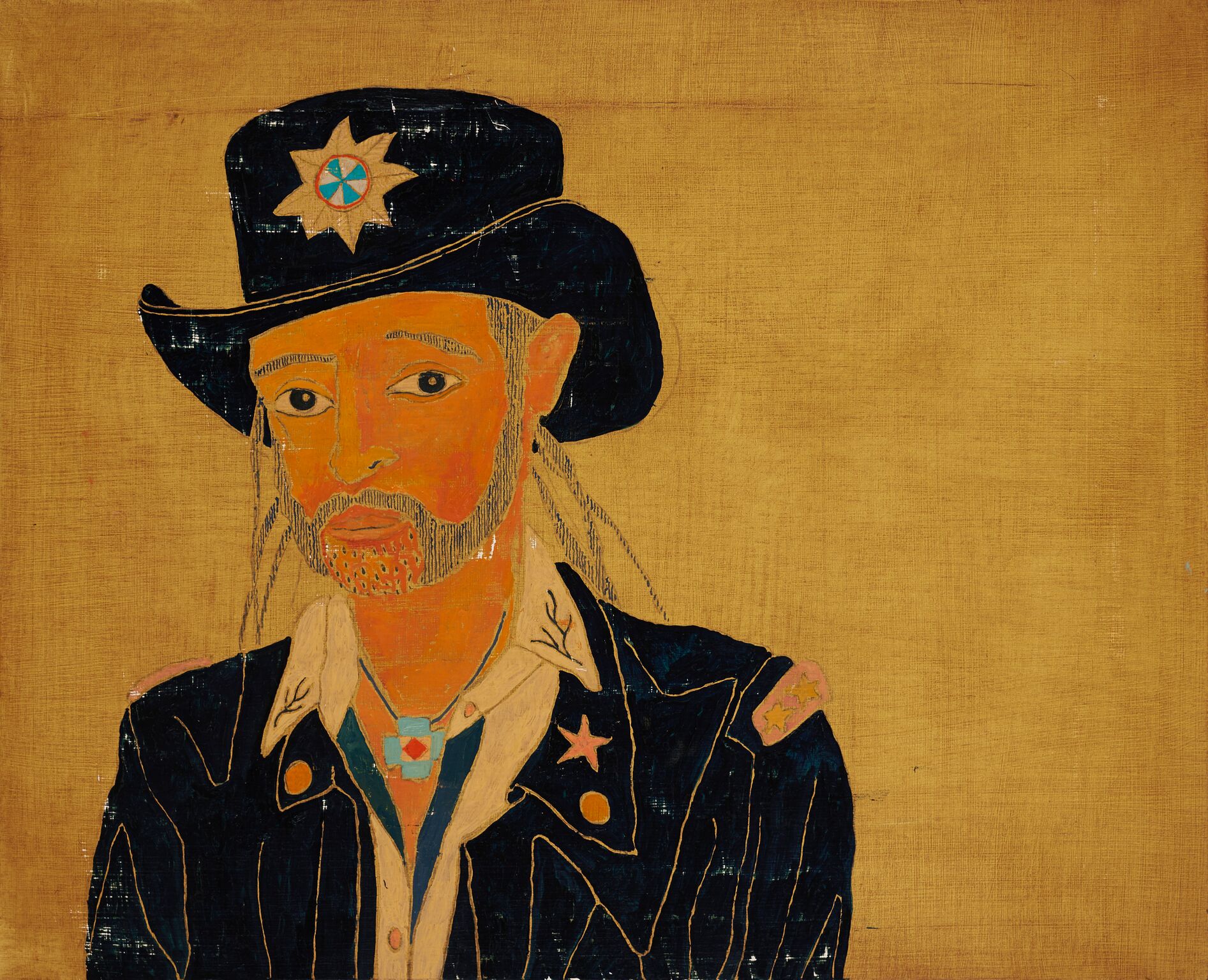
This feature originally appeared in Issue 31.
As I do battle with the delays on the District Line to arrive flustered at the Academicians’ Room in the Royal Academy to meet Stephen Chambers and discuss his forthcoming exhibition, he is already comfortably ensconced. Snuggled into a big woolly jumper, he’s working on his iPad, having beaten the rush-hour traffic by travelling into central London on his ubiquitous scooter. Although for many years Chambers has been a near neighbour, this is the first time we’ve sat down to have a serious discussion on art. He asks me what I’d like to drink. “I don’t normally drink when I’m doing interviews,” I tell him. “Well, it is cocktail time,” he says. “I’m going to have a mojito.” So I join him.
Elected an Academician in 2005, Chambers’s trajectory to Burlington House and his show The Court of Redonda, curated by the Eagle Gallery’s Emma Hill as a collateral event to this year’s Venice Biennale, was far from certain. His mother was a book illustrator and his father a building surveyor, and Chambers was brought up in what he calls “the privileged bohemian West London of the Sixties”. He went to school with Tony Benn’s son. Holland Park Comprehensive was much favoured by Sixties intellectuals. “But I left with no exams. Just Art ‘O’ level, and not a very good grade at that,” he tells me as our drinks arrive. “I was a posh fat boy at the local comp and just fell behind. When my parents split up I was sent to a grammar school in Hampshire but felt out of my depth academically. I did, though, learn German.”
Was he brought up with art? “Well, there were reproductions of Bruegel, Degas and Dufy on the walls. The usual stuff.” But it was a foundation course at Winchester that, eventually, led to an MA from the Chelsea School of Art and a clutch of scholarships and awards, including a Rome Scholarship, the Mark Rothko Memorial Trust Travelling award, and, in 1998–99, the post of Cambridge Fellow at Kettle’s Yard and Downing College. Throughout his career Chambers has paddled his own idiosyncratic canoe, eschewing fashion to remain a resolutely figurative and decorative artist, whose immediately recognizable works create esoteric myths and narratives.
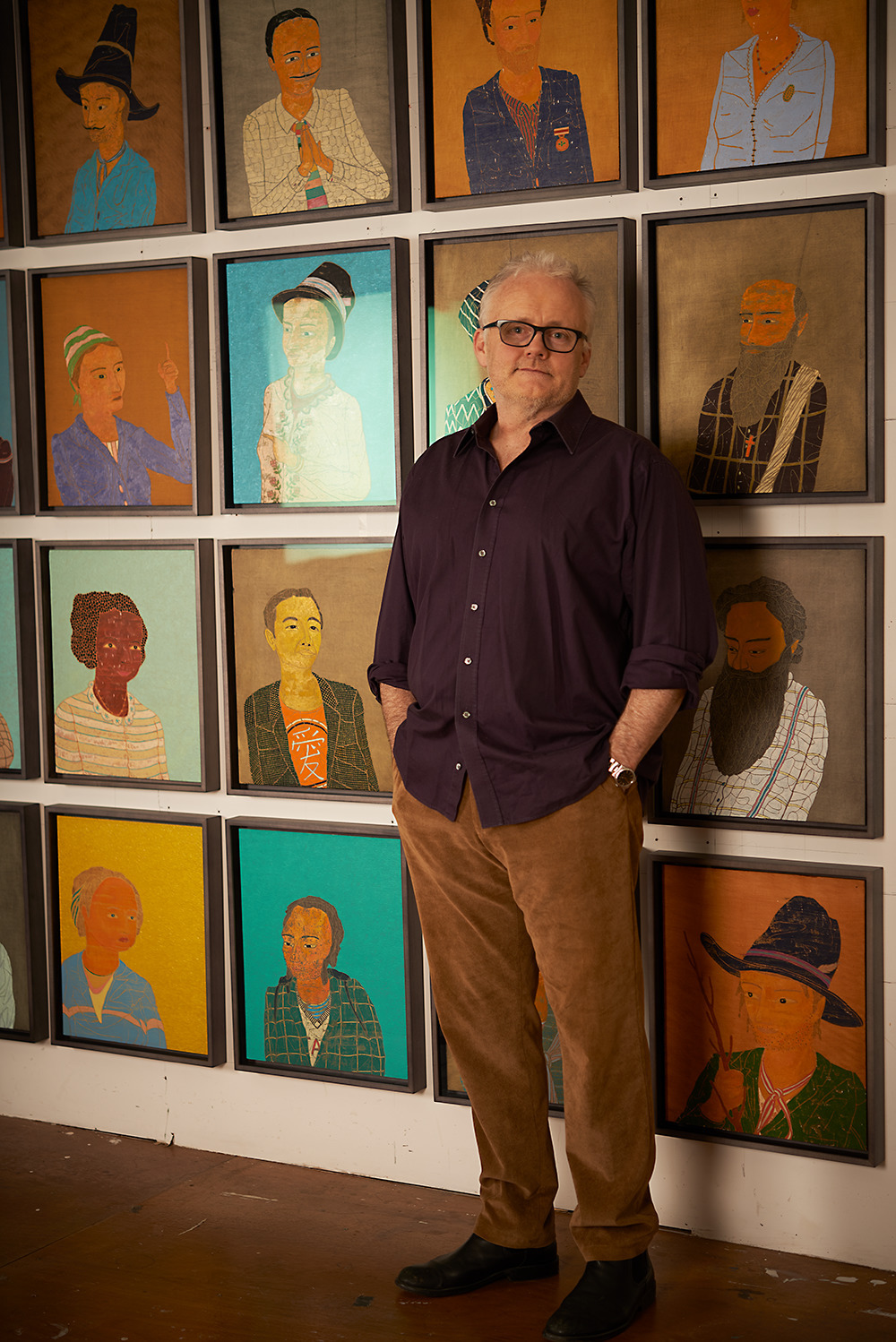
So how, I ask, did he get the idea for The Court of Redonda? “Well,” he says, “I decided to step outside the commercial gallery system. I’m not really a club person, despite the fact that we are sitting in the RA. I began to find making paintings for exhibitions less and less interesting. I wanted to explore bigger themes. My only regret is that I didn’t do it years ago. I like to work in different places and in 2014 had a studio in Brooklyn. Just down the road there was a very interesting bookshop. I was on my own so hung out there two or three times a week and did a lot of reading. I discovered the Spanish novelist Javier Marías, whose best-known work in this country is A Heart So White.” Marías also wrote a novel, Todas las almas (All Souls), which includes a portrayal of the poet John Gawsworth, the third king of Redonda.
Redonda is, in fact, a tiny, uninhabited island in the eastern West Indies. “A round lump of rock,” according to Chambers, “that’s good for nothing.” Discovered by Christopher Columbus in 1493, who claimed it for the Spanish Crown, it was named Santa María de la Redonda. In 1865, it came into the procession of a merchant trader, Matthew Dody Shiell, who claimed it as his own personal fiefdom and crowning his fifteen-year-old son, Matthew Phipps Shiell (1865–1947), as monarch. The latter subsequently moved to England, where he had some success as a science-fiction writer, popularizing the legend of his royalty to the level of an “alternative fact”. Before his death in 1947, Shiell decided that the crown should not be hereditary but passed down through a literary line, and appointed the English poet John Gawsworth as his successor. He assumed the title of Juan I Gawsworth. “Nobody else wanted the place,” Chambers says. “It has no history of substance, no independent raison d’être.” Permanently impecunious, John Gawsworth discovered that selling Redondan knighthoods in a variety of London pubs was a good little money-spinner. He bestowed honours on numerous literary friends to create an esoteric court of writers, poets and ne’er-do-wells.
Although the fate of the Redondan monarchy was contested after the death of Gawsworth, the “reigning” king, Jon Wynne-Tyson, abdicated and passed the crown to Marías in 1997; a title he held until 2012. These events were chronicled in his “false novel”, Dark Back of Time, inspired by the reception of Todas las almas. Many claimed—falsely, according to Marías—that they were the source for characters in the book. “A pub in Southampton,” Chambers says, “even tried to get round the smoking ban by declaring themselves to be the Redondan Embassy in Britain, insisting that people could smoke on ‘foreign soil’. They took their case to court but lost.”

He became, he explains, intrigued by the idea of creating a court of Redonda. To date he has painted around a hundred portraits on wooden panels of 48 x 39 cm—“a convenient size to pack in a suitcase”. Painted in oil on wood, they hark back to the archaic panel-painting techniques of the sixteenth century. “There is,” he continues, “a degree of narrative within each painting. Some people have hands and hold hats or pens. Others are more truncated. I wanted them to be visually seductive but not too well-bred or elegant.” The narratives are largely oblique. I suggest that they conjure up the alternative narratives and fantastical stories of writers such as Italo Calvino, Jorge Luis Borges and Jeanette Winterson, that they don’t quite feel modern. “Well,” he replies, “I remember a conversation with Paula Rego, when she said that if you set something now it’s out of date tomorrow. I took that on board. These paintings exist in some recent fantasy past.”
He envisages them as a single work, an invitation to the viewer to speculate not only on the various relationships of those portrayed but a chance to create a silent communication between individual subject and viewer. Never didactic, Chambers wants them act as catalysts for the fabrication of possible narratives. Executed in his hallmark style, they pay tribute, in their formal construction, to the flattened perspective of Il Sassetta and the naturalistic expression of Masaccio, and reflect his many visits to Italy. Although he could, he says, have sold individual “portraits” many times over he has always refused. He’s chosen, he says, to show them behind glass in order to give them a certain gravitas. He enjoys that the glazed surfaces induce a slight reflection of the viewer so he or she becomes a part of the work. Roughly lifesize, his cast of characters invite immediate eyeball-to-eyeball communion between viewer and viewed.

He starts by using charcoal on a coloured ground when the images are, to use his words, “quite raw”. He’s keen that they should not be too generic. “I’m not a portrait painter but I want them to have their own character,” he says. “The job of artists is to be curious and take risks, to make decisions. I don’t want the images to look too finished or contrived. I just do the best I can, with all the inherent awkwardness that entails. I want the work to have a not-quite-good-enough quality, otherwise it’s simply craft. Virtuoso painting is boring.”
The installation in Venice will be arranged in the shape of the island on the walls of the piano nobile of a seventeenth-century palazzo, Ca’ Dandolo, in order to reflect the kingdom of Redonda. The “court” is counterpointed with three large canvases entitled The State of the Nation, which, with their tumbling rider, hint at the precarious state of contemporary politics. “The first painting,” he explains, “is about Brexit, the second takes place during the campaign and the third reflects the result.”
I suggest that Venice and its associations with travel and crossroads, with literature and art, is an interesting environment for this exhibition. He agrees. “The umbrella theme is migration and Venice is the perfect location. A port, a hub, the starting point for adventures. These works are the ignition point of unresolved narratives, a web of fact and fiction, a meeting of East and West.” Drawing on a range of narrative influences Chambers has created an extraordinary parallel universe filled with his imaginary courtiers—a world where past and present intersect; where myths and fiction hold up a mirror to a labyrinth of infinite creative possibilities.
“The Court of Redonda” continues at Ca’ Dandolo, Venice, until November. Buy Issue 31.
